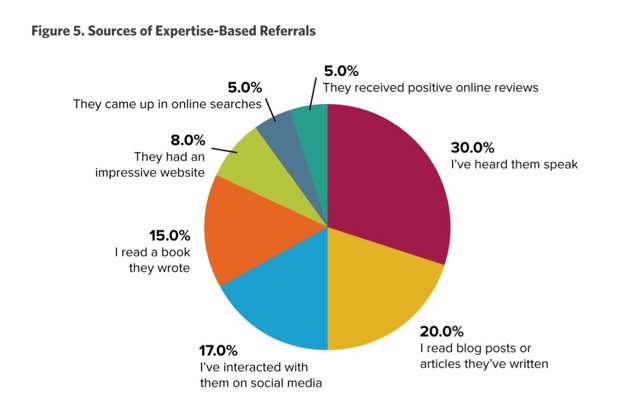Starting a new blog is exciting, but it can be a little intimidating. First and foremost, you want to produce educational content that is valuable to your target audience—it will set you apart as a thought leader.You know the material. You are the expert. But sometimes there are roadblocks to success. Here are five common mistakes new bloggers face, and my advice on how to best avoid them.
Mistake #1: Creating content without a strategy
Online content based on a thoughtful content strategy can help you reap expertise-based referrals. As you see in the figure below, reading blog posts motivates 20% of this type of referral. It is a large slice of the pie, which is why it is wise to start with a clear strategy—before you start writing.

 Your content creation efforts should always be tied into your larger marketing goals. By ensuring your blog plans support your other marketing efforts, you can get the most out of your content. How? Tie your blog posts back to the services you offer (indirectly and not in a promotional way). It will help keep your blog topics well coordinated.
Your content creation efforts should always be tied into your larger marketing goals. By ensuring your blog plans support your other marketing efforts, you can get the most out of your content. How? Tie your blog posts back to the services you offer (indirectly and not in a promotional way). It will help keep your blog topics well coordinated.
Mistake #2: Blogging for yourself—not your audience
The biggest concern new bloggers have when they first start out is having enough content. That may be we often see bloggers writing about what is of interest to them. It may be a good place to start, but it may not lead to long-term success. It is better to look to what your clients want to know.
Let the concerns of your clients inform the topics you write about. Talk to your sales or business development colleagues. They can be a great resource to identify trends and problems that are consistently left unresolved in your industry. Then build content to address those issues.
And don’t be afraid to reach out to people in your organization for their ideas. Encouraging others to write for your blog can be great for new insights and diverse voices. Better yet, invite other bloggers or influencers in your industry to write a guest post for your blog. It is another great way to bring in new perspectives that would be of interest to your target audience.
Mistake #3: Failing to plan (may mean you are planning to fail)
Let’s be honest, blogging can be time consuming, especially if you don’t have the right processes in place to maximize efficiency.
Use a content calendar to plan your content. It can help you manage your time better and ensure you stay true to your content strategy. Plan the topics you will be covering a few weeks ahead. That way you won’t waste time thinking about what to write.
Of course, life can always throw a wrench in even the smoothest operation. So consider writing several posts in advance. That way you have a stash of content on hand for when priorities shift.
Mistake #4: Ignoring search engine optimization (SEO)
It doesn’t matter how good the content is if no one sees it. That is where SEO comes in.
As you plan out your content, make keywords a significant part of your planning process. With each blog post, incorporate a relevant keyword in the title. The same keyword should also appear naturally two to three times throughout your post.
Not sure how to choose the right keyword? Choose what your target audience is using in their online research. That way your prospects will find your content when they are looking for information or an answer to a question.
Failing to optimize your content for search engines will cost your blog posts valuable traffic and leads.
SEE ALSO: SEO Checklist: How to Make Your Tech Firm’s Website More Visible In Search
Mistake #5: Not promoting your blog
Writing a witty, relevant blog post does little good without the right promotion plan. To increase the visibility of your organization and build your brand strength, you must dedicate time for blog promotion.
Share each blog post on your company’s social media channels and encourage other employees to share your blog in relevant LinkedIn Groups. In addition to promoting posts as they’re published, promote archived posts by linking to them in new blog posts when the topic is relevant.
The Long View
There is a lot to think about when you start out with a new blog, and it’s easy to get overwhelmed. Here is a quick checklist to keep you on the road to success.
- Develop a content strategy that aligns with your marketing goals
- Research topics and issues of interest to your target audience (the clients you would like to attract).
- Create—and follow—a content calendar.
- Identify keywords and incorporate SEO.
- Develop a promotion plan.
Be patient. Content marketing is not a quick win. It takes time, persistence and a vision for the long view. Thoughtful and relevant blogging will help elevate your firm’s visibility and reputation as a thought leader.
Additional Resources
- Download Hinge’s Content Marketing Guide for Professional Services Firms for tips on creating content that builds credibility and demonstrates expertise.
- Get a copy of our Online Marketing for Professional Services book to learn techniques that will generate more leads and increase awareness of your firm.
How Hinge Can Help
Content marketing is at the heart of Hinge’s flagship Visible Expert℠ program. It is the leading marketing program for delivering greater visibility, growth, and profits. This customized program will identify the most practical offline and online marketing tools your firm will need to gain new clients and reach new heights.


